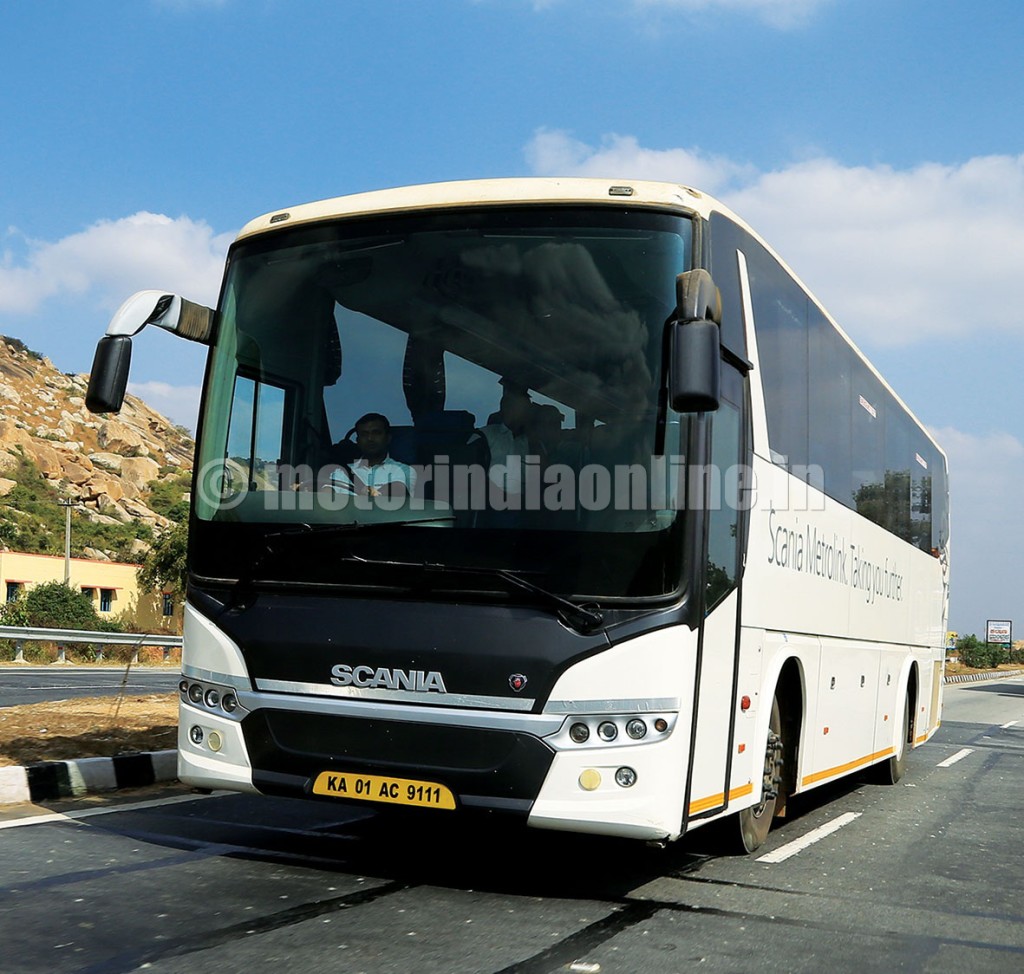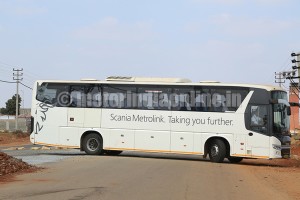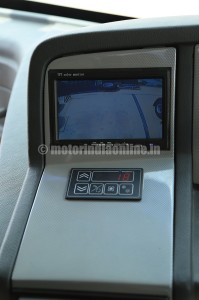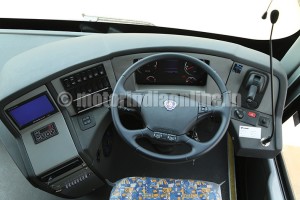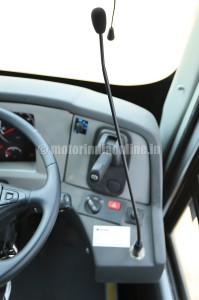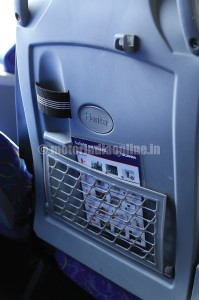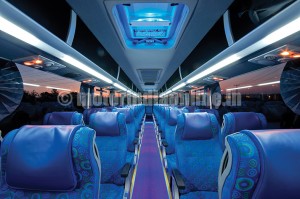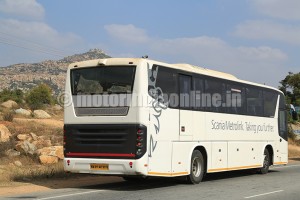We have yet another globally-renowned coach manufacturer making an entry into the Indian market. Scania is here in India with a great appetite to break the existing monopoly in the premium luxury inter-city coach segment. Scania is almost starting from a point where its competitor has come almost a decade and has laid foundation not just with customers but with passengers as well. With strong foundation and almost first-time brand being recalled for a luxury travel, the company is pushing its limits to take a pie from the niche and of course rather small segment.
The bus market TIV is spread across various segments like city, inter-urban, inter-city and special applications. In this, the inter-city segment contributes up to 25 per cent of the TIV. This is further sub-segmented based on features such as non AC Seater and Sleeper, AC Seater and Sleeper, operation of coach as short distance up to 350 km, medium distance up to 750 km, long distance up to 1,250 km and ultra-long distance of anything above 1,250 km and up to 1,750 km and comfort features like Economy, Value and Premium. Premium coaches contribute less than two per cent of the total TIV, and this is where Scania wants to have presence. Let’s find out what exactly Scania wants to offer the Indian passengers through its Metro Link range of coaches.
Product and positioning
Scania is globally known for luxury and premium coaches (though it does have front engine chassis and F-Series in select South American market) and positions itself like to like with Mercedes, Volvo and other premium coach manufacturers. Its Indian operations are also planned in the same way, be it coaches, pullers and also tippers.
Ultra smooth tarmac for hundreds of km (thanks to NHAI for formulating them), higher spending ability of the urban youth, greater connectivity, increased frequency, population being more cantered around metros and their reduced availability of time to travel to the native place and back during weekends are a few of the major points that are considered as growth drivers for the inter-city segment as well as the premium segment.
When Kesineni launched its Coimbatore-Hyderabad service some four years back, nobody thought this could be so viral that bus travel can get extended up to 2000 km and that too for 34 hours non-stop between Bangalore and Jodhpur. This should speak about the potential and the importance of the segment, even though its size is currently small. There are a lot more routes and destinations available, and operators are exploring them as and when the demand pick-up. And it will be no surprise when we see our Capital getting connected with IT Hub and Rajdhani Express facing fierce competition.
With so much travel being done the prime and most importance key user factor is comfort. When we say something on comfort, it may refer to many things. Comfort starts from cushy and bolstered seats, air condition, saloon noise, adequate seat pitch, head room, gangway and, of course, ample luggage space. With all this in place coaches are now going places unheard of in history. Sure this segmentation wouldn’t have been possible without the availability of comfortable and reliable coaches. Metro Link coaches are no different and will definitely be a great catalyst in the way we Indians will travel. Currently Scania offers Metro link coach in three different lengths of 12M, 13.7M and 14.5M. These coaches can take up to 45, 53 and 57 seats respectively for standard seating layout with foot rest only.
Scania at the outset has received good response from the operators. What Scania has done is it has announced its arrival much earlier and has done a complete customer clinic with major fleet operators ever since early 2012. They were given proper introduction about the company plans in India and the level of indigenization they will be adopting and, most importantly, the investment they will be making in India. With all this in place, customers were given a sneak preview of the new range of coaches and were well informed about the same.
Apart from this, the current pain points and future requirements of customers were completely overheard by Scania and have developed the specifications for India. They also ensured that they offer superior product features which will be an USP as well.
Exteriors
Metro-link coaches follow a similar design theme, all around. There is no visible change throughout, but for the tag axle. The front is very much flat and thick parting lines. Three headlamps on each side with black embracers making them feel very much distinct. Facia is made in FRP with exterior over with lowered headlamps and fog lamps. External rear view mirrors are big with convex and corner mirrors on both sides. The mirrors are powered option of heating as well. Side profile is rather clean slate with aluminium stretched panels. The skirt is rather low with pantographic opening luggage compartment. They require minimum effort to open as well. There are six side glasses with the first and the last being unique and others just common. Not to mention that the first row of seats are the all-time favourite with lowest in saloon noise and with highest travel comfort.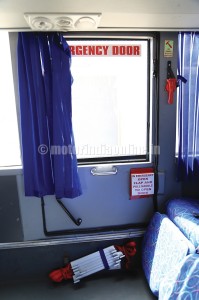
The rear profile is finished with rear windscreen, openable engine flap door. The engine flap door has thick, wide and deep louvers and the same profile extends till the rear tail light clusters. Though lights are individual with one of each parking lamp, brake lights, turn indicators and reverse lights, their shoulder gets integrated with the profile of engine flap door.
Also the shut line goes along the split bumpers in the lower end and profile lines in the top side. The funnel-shaped profile gets starts from the rear windscreen and further goes down with small grill. Though this differentiation – Funnel and engine flap is purely a paint job, they look better. But understand this may not the same always, and will be left to the customer’s choice.
The reverse camera in integrated into the profile and is located in the top of the rear windscreen. The cooling system and air intake system louvers are on the left side and are the same for all three coaches. The higher the air intake pipe, the fresher the air, and so is positioned on the upper side and this part of chassis, where the air intake system is fitted is integrated into body with extended pipes.
The fuel tank flap is provided on both sides of the front over hang (FOH) which comes with 465L capacity tanks. With this the coach range can go up to 1000-1300 km. The body structure is made of GI tubular structure and is coated with anti-corrosive paint for better rust protection.
Interiors
Entrance is through an out-swing passenger door – yes, a changeover in the rear engine coaches. With this, the passenger entrance door is less disturbed and is free for passenger movement with a width of 945 mm. The saloon is rather flat from front to rear and has a gangway width of 385 mm.
Seats are provided with individual service sets and are with individual AC louvers for two passengers, reading lights and integrated speakers. The louvers have both direction and flow control. The flow control was little tricky as we need to rotate the louver base to adjust the air flow. Also, if required additional speakers are provided at the bottom of hat-racks. Due to this, the entire space in the hat-rack is freed up for luggage. Hat rack depth is around 275 mm. The hat-racks end little in front of the last row, making better head rooms. Additional louvers for last row are given vertically in the hat rack wall.
The seats are supplied by Harita which currently has its monopoly in the luxury seat market.
We were able to see better reclining almost near same as other row of seats in the last row. Saloon lights are placed just at the bottom of the hat-racks throughout. There are two roof hatches and double as emergency exits in case of emergency. AC return air duct is provided in the centre and free flows are directed towards hat-racks. Hence this there is no air curtain alongside the windows.
The side pillars and upholstery are finished with vacuum formed panels with hammers to break the side glasses in case of emergency. All the side glasses are breakable, and a fire extinguisher is provided below the last row and signage is given behind the RH last row seat. Charging points near the floor in each row in between seats and is backed by 1.5kW inverter.
With Apple and Samsung doing value engineering with the power cable lengths, it’s quite obvious that mobiles may not be reachable if you recline completely with calf support. In fact, high chances they need to be placed only in the seat pockets exposing it vulnerable for theft. Wished they are provided in the height equal to seat push lever making it convenient and to use while charging. Flooring is made of 12mm boiling water proof plywood throughout with anti-skid vinyl sheet.
Driver work area
Scania has done a great job in providing excellent driver work area. The dash is clean with limited switches and instruments. The main cluster itself has only speedometer, tachometer, temperature gauges and fuel gauge. There is no provision even for air pressure gauges. There is MID in the center of the cluster displaying details on gears, mode of operation and on-board diagnostics.
The error codes are read from multiplex system and are thrown in the display window. The driver seats are pneumatically powered and are positioned in the right place. Steering is rack and reach, adjustable, with horns placed in the steering wheel as well. The left combination switch has controls for indicators, wiper washer and wiper and right combination switch for Opticruse operation.
Opticruse
Opticruse is the Automated Manual transmission version of Scania. This is the biggest USP for Metrolink. Opticruise is fully integrated in the gearbox range. This results in significant improvements with respect to precision, gear selection, performance and reliability.
Before getting into the technicalities of Opticruse, AMT has, by and large, some big advantages over the manual and fully automatic gear. They are cost-effective alternative solution offering the same benefits as automatic gear boxes. They are simpler in construction, easy for overhaul and for regular maintenance. Due to precise gear selection and shifting the entire driveline experiences lesser vibration and is completely independent of the driver skill level. So is the increased reliability and lifeline as well. The first one to see this improvement is the life if clutch disc and is up to 3 times higher than the manual. Also with the right gear at the right speed always, the fuel performance is better and is again independent of driver skills. “Of course, no system can replace or bring better performance than an experienced driver. The system tries to reduce the variations from various drivers. As a result, fleet fuel performance is likely to be better.
When introduced in 1996, Scania Opticruse was one of the first automated gear changing systems in the market, and it took driver comfort and driver support to new levels. Continually refined ever since, the latest version, introduced in 2009, features all-new software and refined functionality, e.g., with integrated manoeuvring mode and automatic rocking mode, as well as power mode and kick-down.
Customers can choose between the fully-automated version and the one with a clutch pedal. The automatic clutch is electro-hydraulically operated, providing exceptional precision and smoothness.
The entire function of AMT operation is controlled by RH combination switch. The forward and rear movement makes upshift and downshift and Manual and Auto Mode is affected with side press button of the switch.
All driving modes are controlled by toggling the ring switch on the Opticruse lever, and the mode engaged is indicated in the central instrument:
A – Automatic (normal mode)
M – Manual (normal mode)
AP/MP – Power mode (automatic/manual)
N – Neutral
R – Reverse
Driveline
Scania offers three different engines for three different lengths of the coach. The 12M coach comes with DC09, 9-litre 5-cylinder BS III engine. This is the only 5-cylinder engine in India. The 13.7m and 14.5m coach is fitted with 13L engines with different states of tune of the DC13 6 cylinder – 360hp and 410hp developing 1750Nm and 2000 Nm of torque at just 1100 rpm. All these common rail engines are turbo charged and inter-cooled, with unit injections with 4 valves / cylinder. They are all with 8-speed Opticruise with varying ratios to manage the input torques.
The cooling system is via the hydraulic PTO-driven remote mounted radiator. Compared to the legacy remote fan drive cooling system, which draws more power and requires maintenance like belt replacement. The hydraulic cooling system is more fuel efficient and draws lesser power. Also this saves a lot of space, as they can be fitted sideways unlike in RFD where engine and cooling system should be fitted only on the cross wise direction. So fitment on sideways means that we can have wider radiator core, which essentially will be with reduced height and so is more space below floor area, eventually increasing air flow, reducing the heat inside saloon compartment in last row.
Suspension
Coaches are suspended pneumatically, with two bellows on the front, four at the rear live and two at tag axles. They are electronically controlled, and so depending upon ride and terrain, the coach can be lowered and raised with the touch of the button in the driver work area. The suspension fitted in Scania buses have a larger center of gravity, i.e., all air bellows are away from the chassis cross members resulting in more stability and better control for Drivers during turns and overtakes . Overall this additional feature gives better comfort, higher stability and road grip, superior stability even at high speeds.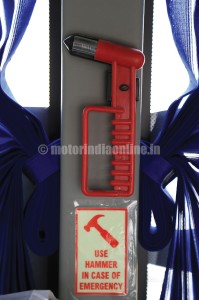
With more than 40 coaches on road and running across States, Service plays a crucial role in making coaches available. Scania has very well placed its network across key points in all states. The company does have onsite service support and its mobile service ensures availability of coaches. Scania has seven dealers operating in 14 support points.
Safety features
Disc brakes in all wheels | ABS and electronic braking system | Traction control | Gear box integrated retarder | Automatically controlled exhaust brake system | Electronic stability programme | R66 roll-over compliance structure | Seat belts | Radial tubeless tyres for better road grip and stability | Speed lock to stay within safe limits ( 85 km/h) | Emergency rescue door at the rear on the right side | All window glasses are breakable | Emergency hammers on all windows (all side windows can be used as emergency exits) | Fire detection in engine compartment | Fire extinguishers | Reversing camera | Flight like safety video and safety cards, to educate passengers on what to do | Real-time fleet management system | Automatic fire suppression system (optional)
